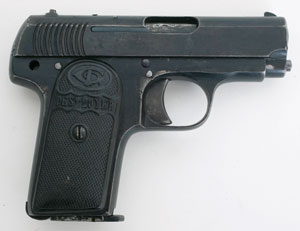ERSKINE CHILDERS EXECUTED
Published in Issue 6 (November/December 2022), Volume 30By Joseph E.A. Connell Jr

Above: Erskine Childers was charged and convicted in a military court of possession of this ‘Destroyer’ pistol, a gift from Michael Collins. (Military Archives)
On 27 September 1922, Dáil Éireann passed emergency legislation that allowed for the execution of those captured bearing arms against the Free State. The legislation passed to the National Army powers of punishment for anyone ‘taking part in or aiding and abetting attacks on the National Forces’, having possession of arms or explosives ‘without the proper authority’ or disobeying an Army General Order.
At cabinet level, a unanimous decision authorised the execution policy, and Kevin O’Higgins, the then justice minister, stated: ‘It was done deliberately and in the belief that only by that method could representative government and democratic institutions be preserved here’. President Cosgrave said: ‘They are dealing with the dregs of society, people who had no regard for life or property or all that people held dear’.
Following passage of the act, the first executions took place at Kilmainham Gaol on 17 November 1922, when four anti-Treaty Volunteers were executed for possession of revolvers: Peter Cassidy, James Fisher, John Gaffney and Richard Twohig. Labour leader Thomas Johnson TD protested in the Dáil but Gen. Richard Mulcahy argued that, although he knew that people would be shocked and saddened by the executions, ‘stern measures had to be taken or assassins and wreckers would destroy the country’.
Cassidy, Fisher, Gaffney and Twohig were the tragically chosen ‘rank-and-file Volunteers’ who were to become the ‘lesser-known victims’ of the Free State’s official retaliation execution policy. Very shortly after their deaths, it began to be whispered that the Provisional Government had intended to soften up public opinion in advance of the execution of Erskine Childers by executing these lesser-known victims first. It was thought that if Childers, who had been captured on 10 November at his home in Glendalough, Co. Wicklow, was executed first, too many questions would have been asked about the ‘retaliation execution’ policy.
Childers was the anti-Treaty director for propaganda, but he was often ostracised from the anti-Treaty forces and referred to as ‘that bloody Englishman’ owing to his foreign birth. Many in the IRA high command of the anti-Treaty forces distanced themselves from Childers on the grounds that he was too infamous to be of any practical use, despite his considerable military experience. He was tried by a military court on the charge of possessing a Spanish-made ‘Destroyer’ .32 calibre semi-automatic pistol, which had been a gift from Michael Collins. Childers was convicted by the military court and sentenced to death on 20 November. While his appeal against the sentence was still pending, he was executed on 24 November by firing squad at Beggar’s Bush Barracks.
Jurists in Ireland and Britain generally regard this particular execution as judicial murder, for Childers was executed before his legitimate appeal, which had been granted, could be heard. As a result of this execution, the IRA/Republican Executive decided on a policy of summary execution of prominent Free State figures, and Childers’s death caused Liam Lynch to abandon all ideas of making peace. It was immediately following this that Lynch issued his ‘Orders of Frightfulness’ that led to the shooting of TD Seán Hales.
After this, the Civil War entered an increasingly grim phase.
Joseph E.A. Connell Jr is the author of The Terror War: the uncomfortable realities of the Irish War of Independence (Eastwood Books).
















